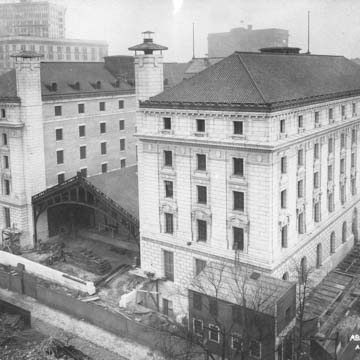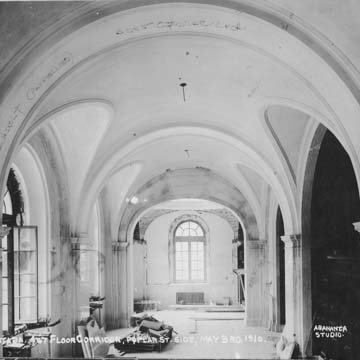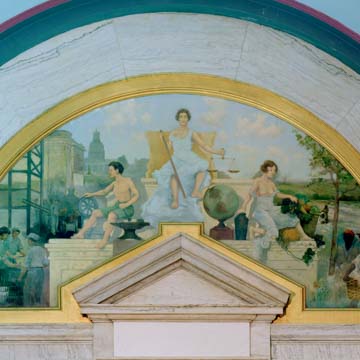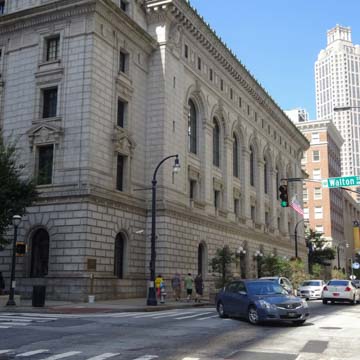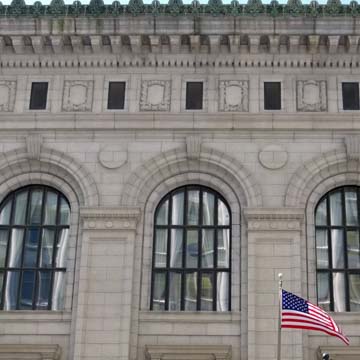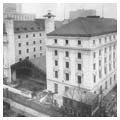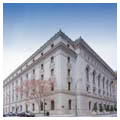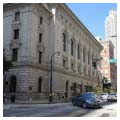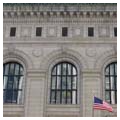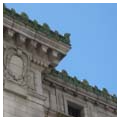You are here
United States Post Office and Federal Court Building
As Atlanta rose from the ashes of the Civil War, expanded as a city, and grew in population, increasing needs for federal services prompted the U.S. Congress to approve the construction of a new post office and federal courts building. Designed by James Knox Taylor, supervising architect of the U. S. Treasury Department, the new post office was constructed in 1907–1911, with the interior completed by 1914. Taylor’s design, a palazzo in the Second Renaissance Revival style, filled the entire block between Forsyth and Fairlie streets on the east and west, and Poplar and Walton streets on the north and south. The landmark building was sited at the very heart of the turn-of-the-century business district, in what is now known as the Fairlie-Poplar Historic District.
The building rises five stories in a U-plan whose open rear court on Fairlie Street serves as a postal loading dock, marked by a riveted steel and glass canopy. Exterior walls utilize Stone Mountain granite with buff-colored brick in the courtyard. The main facade faces Forsyth Street and extends the full width of the block, projecting a center section of seven bays with arched windows lighting the courtrooms behind. Side elevations are symmetrical with multiple bays, some of whose windows are surmounted by pediments or segmental arches with bracket supports and keystone cartouches. The lower level is rusticated, with articulated carved granite above organized by stringcourses with medallions and wave motifs, regular bays, classical balustrades, and molded cornice and terra-cotta roof edging. Some features are symbolic: the serpent and staff (the Caduceus), here seen on keystones; a symbol of Mercury, the Roman messenger god, was adopted as a symbol of early postal services; and the fasces (bundled rods with axes), traditionally carried in front of Roman lawgivers by Lictor, an official of the Roman court, are also evidenced here and are symbolic of the rule of law. Inside, a mural by an unknown artist that predates those of the Works Progress Administration, depicts Justice flanked by Agriculture and Industry.
An array of materials are utilized throughout the building: Georgia marble for staircases, door and window trim, and wainscoting; terrazzo for top-story flooring; and maple herringbone in the main courtroom. Courtrooms are decorated with stained oak paneling with garlands and plaster coffered ceilings, and the first-floor lobby is vaulted. Although the post office and court building was renovated in the 1930s, and again more substantially by Robert and Company in 1986–1987 after the Eleventh Circuit U.S. Court of Appeals was established here in 1981, the main public spaces including the historic courtrooms are generally intact.
Prominent cases heard here include two widely published in the year 2000: the case of Elian Gonzalez, a young Cuban boy who was rescued off the Florida coast after his mother died during an attempt to enter the United States, and the case resulting from the vote counting and “hanging chads” on paper ballots in Florida voting machines following the presidential election between Al Gore and George W. Bush, although the cause célèbre was eventually decided by the Supreme Court.
Writing Credits
If SAH Archipedia has been useful to you, please consider supporting it.
SAH Archipedia tells the story of the United States through its buildings, landscapes, and cities. This freely available resource empowers the public with authoritative knowledge that deepens their understanding and appreciation of the built environment. But the Society of Architectural Historians, which created SAH Archipedia with University of Virginia Press, needs your support to maintain the high-caliber research, writing, photography, cartography, editing, design, and programming that make SAH Archipedia a trusted online resource available to all who value the history of place, heritage tourism, and learning.












